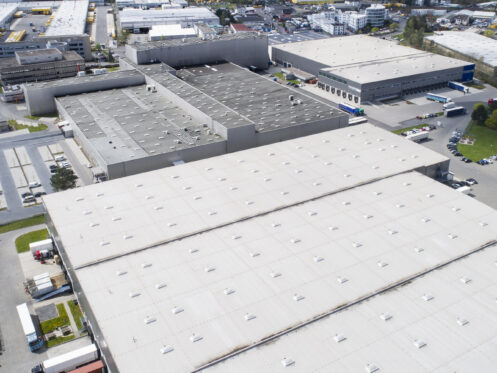Choosing the right commercial roofing material is essential for protecting your business property. Roofs play a critical role in your building’s overall structure. The roof protects your business from outdoor elements like harsh sunlight, rain, wind, hail, or snow. It also serves an important role in proper ventilation as well as temperature regulation. There are a number of commercial roofing materials available to meet the needs of different types of businesses. Each kind of roofing material has its own set of benefits and considerations. But given the variety of options, making the right choice for your company can be daunting. A detailed look at the most popular commercial roofing systems can help you make an informed decision for your business.
Thermoplastic Polyolefin Roofing
Thermoplastic polyolefin (TPO) is a synthetic roofing material that is highly resistant to solar ultraviolet (UV) radiation. This material consists of a single-ply membrane usually made from a combination of polypropylene and ethylene-propylene rubber. Manufacturers polymerize the two components together to create a durable covering for your building. TPO comes in a range of colors suitable for businesses like white, gray, and tan, and a roofing contractor can install it via mechanical attachment, adherence, or ballasting.
Benefits of TPO Roofing
TPO is an innovative material that is more economical than other roofing options. The top benefits of TPO include UV resistance and weatherability. It reflects the sun’s rays instead of absorbing them, and it repels water or moisture. These traits also make TPO resistant to other sources of deterioration like mold, rust, corrosion, mildew, debris accumulation, and accidental impact.
Drawbacks of TPO
Because TPO is a newer type of material, research is still ongoing about its longevity compared to similar roofing materials. TPO may have a shorter lifespan than comparable materials like PVC. This material also requires highly experienced contractors to avoid installation-related failures such as tears that can lead to roof or ceiling leaks.
Ethylene Propylene Diene Terpolymer Roofing
Ethylene propylene diene terpolymer (EPDM) is a synthetic rubber membrane made of a flexible blend of ethylene and propylene. It is a single-ply material that comes in large, durable, lightweight sheets. EPDM has a track record of endurance and reliability that spans 40 years of documented research. With proper maintenance, EDPM roofs can last 25 years or more. EDPM are popular for flat and low-slop commercial roofing throughout the world.
Benefits of EPDM Roofing
Because of its straightforward structure and simple installation, EPDM tends to be less expensive than comparable roofing materials. EPDM comes in a dark or black color that absorbs heat, making it ideal for buildings located in cold climates or cooler regions since it can help lower energy costs there. The dark material is resistant to UV rays all year and can also withstand hail and repel rainwater. EPDM highly flexible, maintaining its strength during temperature fluctuations and accommodating periodic changes to structural movement. It’s resistant to fire or lightning. If you decide to replace EPDM at any point, the material is recyclable, making it an eco-friendlier option to alternatives.
Drawbacks of EPDM Roofing
Because EPDM primarily comes in a dark hue or full-on black, its heat absorption can raise energy costs in extremely hot climates. While you can ask your roofing contractor about a lighter-hued EPDM, this option is not as commonplace on the market. And from an aesthetic standpoint, some business owners find that EPDM has a less-than-ideal appearance or curb appeal than options like TPO or PVC.
Metal Roofing
Metal roofing is famous for its versatility and long service life. Depending on the type of metal, this roofing material can last 70 years or more. Common types of metal roofs include galvanized steel and aluminum though you can also find them in tin, zinc, and copper. A roofing contractor can review building codes and the style of your commercial structure to determine which type of metal is right for your business. Contractors typically install metal in large panels set over steel beams.
Benefits of Metal Roofing
Metal is considered to have a highly attractive and professional appearance and is popular on steeply sloped roofs. Metal lasts nearly indefinitely if maintained and has fewer maintenance concerns than conventional options like shingled roofs. It’s also fully recyclable at the end of its long lifespan, making metal an environmentally good choice for businesses. Because metal reflects heat instead of absorbing it, it may help reduce energy costs during extremely hot weather. Plus, metal is slippery and allows rain or snow to slide off of your building easily. The natural material is also resistant to fire and other hazards.
Drawbacks of Metal Roofing
Metal has a higher upfront cost than synthetic materials. Because some metals are prone to oxidation, they require professional installation with coating to lower the risk of rust. Another reason metal roofs require expert installation is that metal roofing needs proper insulation to avoid potential noise during rainstorms. Metal is also slippery, so business owners should avoid walking on these roofs without the proper equipment.
Polyvinyl Chloride Roofing
Polyvinyl chloride (PVC) is a durable material with numerous applications in commercial construction. PVC is a double-ply synthetic plastic that consists of two distinct layers held together with a polyester reinforcement scrim. The top layer contains additives that make it resistant to UV radiation, wind, or fire. Its bottom layer contains plasticizers that increase flexibility for versatile installation. In fact, PVC is more flexible than rubber. During the production process of PVC, the heat-welding makes the bond between the two-ply layers permanent. This makes the material watertight and resistant to damage from moisture or leaks.
Benefits of PVC Roofing
PVC benefits from a track record of 50 years of industry research, and most PVC roofs can last at least 30 years. Some PVC roofing materials are also ENERGY-STAR-certified since the resistance to sunlight and heat can reduce energy costs by up to 50%. The synthetic material repels natural sources of deterioration like mold, algae, and fungi. PVC membranes are also recyclable at the end of their lifespan, allowing manufacturers to use the same plastic to make new sheets and reducing the risk of waste ending up in the environment.
Drawbacks of PVC Roofing
Because PVC is a durable double-ply material, it has a higher price point than single-ply or cheaper rubber roofs. Since a range of manufacturers market and distribute PVC, it is important to consult with an expert roofing contractor who is knowledgeable about the different options.
Asphalt Roofing
Asphalt is among the oldest and most well-known types of roofing materials on the market. There are two main categories of asphalt roofing: modified bitumen roofing and built-up roofing (BUR). Modified bitumen combines asphalt, polymer, and fiberglass or polyester fibers for a durable construction that is resistant to tearing or leaks. Built-up roofing consists of at least three to five layers of asphalt and aggregate designed to resist outdoor elements or damage.
Benefits of Asphalt Roofing
Asphalt roofs are durable with a history of reliability that spans decades. In fact, BUR has been in use for 100 years. BUR roofs have a long service life and provide insulation suitable for all four seasons. Asphalt can also accommodate foot traffic if you need to walk on the roof.
Drawbacks of Asphalt Roofing
Both types of asphalt roofing can release disruptive fumes during installation. For this reason, many locations require special insurance for asphalt roofing that can drive up the installation cost.
Contact Us Today
Commercial roofing materials help keep your business building secure and in good condition. If the options seem overwhelming, there’s no reason to worry. The experts are here to help. Schmidt Roofing provides commercial roofing services for businesses in Burnsville, the Twin Cities, and surrounding areas. If you have experienced storm damage, we can provide assessments and conduct repairs. Business owners can also conduct us for re-roofing or new roof installation. In addition, we are the experts for gutters, siding, and insulation. Contact Schmidt Roofing today for all commercial roofing needs



